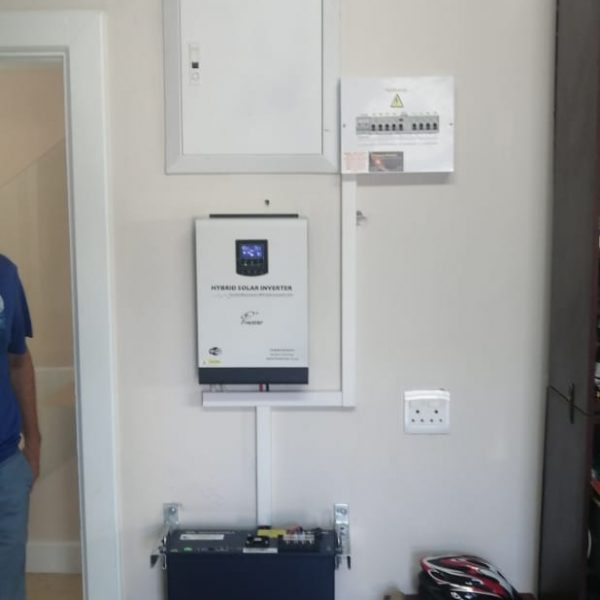Built In Battery Backup
The unit is permanently connected to utility power so that while mains is present the extra large built-in battery charger recharges the batteries and keeps the batteries fully charged until a power failure occurs. The equipment you want to back up is also permanently connected via the system.
In case of a power failure the backup system automatically switches over, via an extra fast transfer switch to the inverter, which will continue to provide power to the equipment within 15 msec. This is extremely fast and standard equipment like TVs, DSTV decoders, microwaves, fans, etc. are unaffected.
When utility power returns, the whole procedure is reversed and the unit will switch back to ESKOM and will automatically start re-charging the batteries. Your equipment remains connected to the system even when power is restored. The whole process is fully automatic.
The amount of backup time is determined by the size of the connected battery bank and the load drawn from the system. The backup time is directly in proportion to the load drawn. The backup time is normally calculated depending what is running (i.e. if the system is a 5kw battery system, you will have about 4kw of power to use as the battery cannot be drained fully) hence for a stage 6 load shedding you cannot drain more than 1kw per hour to be safe. If you increase the number of batteries then you can draw more power.
Yes, but the system has to be correctly sized then you wont have any issues. These systems are capable of bridging power outages from 2 – 24 hours or (e.g. for 2 hours per day twice a day) as the battery chargers are powerful enough to recharge the battery bank to cater for the second outage on the same day (providing there is enough time between the 2 outages – at least 4-6 hours).
These systems require minimum maintenance. Depending on the system chosen, the batteries are Lithium LIPO4. Batteries are maintenance free and do not have to be filled. It is recommended that battery sets are installed in a battery cabinet and are locked in a room with ventilation, where small children do not have access. Lithium Ion units are completely maintenance free and are in their own cabinet with own management system.
A UPS system is designed to backup sensitive equipment like servers, computers, medical equipment, telecommunications equipment, etc. Standard UPS systems have small internal battery sets and can only provide short backup times of approximately 5 – 10 minutes which cannot be extended as the internal battery chargers are small and can only cater for the internal battery sets they were designed for. Additional or external batteries cannot be connected to these UPS systems.
In contrast, inverter based long backup systems do have a small break when they switch over to backup power (irrespective of the inverter system brand or model). The higher quality systems switch over in a very short time and it is hardly noticeable. Inverter backup systems incorporate larger battery chargers which allows larger battery sets to be installed which results in much longer backup times than UPS systems.
In contrast, home long backup systems, which do have a small break when they switch over to backup power (irrespective if the inverter system, but the good quality systems have a power break during switchover which is hardly noticeable), incorporate large battery chargers which enables extra large battery sets to be installed, which results in extra long back-up times.This is not possible. with UPS systems
- Lithium LIPO4
- Small to large Plasma or LCD TV
- DSTV and M-Net decoders
- Surround sound systems
- 5 to 10 energy saver lights
- a Fan
- Fridge and deep freezer
- Home alarm system
- Automatic garage door motor
- Intercom
- Electric fence
- Microwave oven
- Small kettle
- Fax machine
- some standard home Power tools
- Geysers
- Underfloor heating
- Stoves
- Air conditioners
- Washing machines
- Tumble driers
- Dishwashers
- Pool motors













